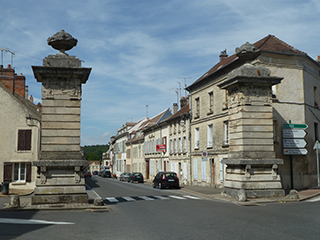Prochain point : lat="" lon=""

Ramparts and Monumental Columns
A defensive system that evolved over time
Imposing city walls...
The city’s defence system, created between 1532 and 1545, included a parapet, rampart and ditches. Its layout is still visible today since it follows the same line as the boulevards that circle the city. The ramparts were simple embankments that clearly would not have been very effective in the event of attack. The entrance to the city was through one of the four gateways opening onto the most popular routes: the gates of Paris, Rouen, Vernon (or Hodent) and Beauvais. In the eighteenth century the new lord of Magny, Olivier de Senozan, claimed to be the sole owner of the fortifications: he dismantled them and recycled the stones for his farms and mills. In 1768 three of four city gates were almost in ruins. The city decided to level the ditches in 1825, planting trees and closing the ditches in with barriers to turn them into spaces for walking.
... and monumental columns, the symbols of Magny
Work on a new layout to bring the main road from Paris to Rouen through the city began in 1764, leading to the demolition of many town houses. When the paving was completed in 1774, all that was left was to redevelop the approach to the city. The Porte de Paris, where the arch was too low, was an obstacle to traffic, and was replaced by two monumental columns measuring 2.60 metres at the base and 7.70 metres high. The columns were decorated with wreaths and garlands, and surmounted by an urn. They were completed in 1778 and came to symbolise the city and its seigneurs. The western column housed a water tank that supplied a public fountain.





